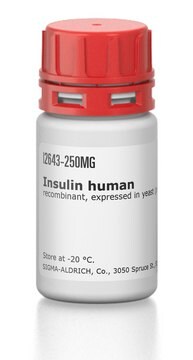Recommended Products
description
Cell line type: Cancer Cells
technique(s)
cell culture | mammalian: suitable
General description
The OVCAR-5 cell line was established from ascites fluid from a non-treated patient with an advanced-stage ovarian tumor (3). The OVCAR-5 cell line has recently been classified as originating from the gastrointestinal tract, not of ovarian origin (4). OVCAR-5 cells harbor a homozygous Gly12Val mutation in the KRAS oncogene and are characterized by migration/invasion ability as well as exhibiting tumorigenicity in nude mice (5). OVCAR-5 cells overexpress claudin-4, a marker that plays a role in cancer malignancy (6). OVCAR-5 cells exhibit aggressive growth and invasion and represent a valuable model for metastatic gastrointestinal carcinoma.
Source:
OVCAR-5 was established from ascites fluid from a 67-year-old untreated cancer patient (3).
References:
1. Nat Rev Disease Primers 2016; 2: 16061.
2. J Obstet Gynaecol Can 2003; 25(10): 819-824.
3. Cancer Res 1997; 57: 850-856.
4. Nuc Acids Res 2016;44(17): e137.
5. Gynecol Oncol 2015;138(2): 372-377.
6. Int J Mol Sci 2011; 12: 1334-1358.
Application
Quality
- Each vial contains >=1X106 viable cells.
- Cells are tested negative for infectious diseases by a Human Essential CLEAR panel by Charles River Animal Diagnostic Services.
- Cells are verified to be of human origin and negative for inter-species contamination from rat, mouse, chinese hamster, Golden Syrian hamster, and non-human primate (NHP) as assessed by a Contamination CLEAR panel by Charles River Animal Diagnostic Services.
- Cells are negative for mycoplasma contamination.
- Each lot of cells is genotyped by STR analysis to verify the unique identity of the cell line.
Storage and Stability
Disclaimer
Storage Class Code
10 - Combustible liquids
WGK
WGK 1
Flash Point(F)
Not applicable
Flash Point(C)
Not applicable
Regulatory Listings
Regulatory Listings are mainly provided for chemical products. Only limited information can be provided here for non-chemical products. No entry means none of the components are listed. It is the user’s obligation to ensure the safe and legal use of the product.
JAN Code
SCC259:
Certificates of Analysis (COA)
Search for Certificates of Analysis (COA) by entering the products Lot/Batch Number. Lot and Batch Numbers can be found on a product’s label following the words ‘Lot’ or ‘Batch’.
Already Own This Product?
Find documentation for the products that you have recently purchased in the Document Library.
Our team of scientists has experience in all areas of research including Life Science, Material Science, Chemical Synthesis, Chromatography, Analytical and many others.
Contact Technical Service



